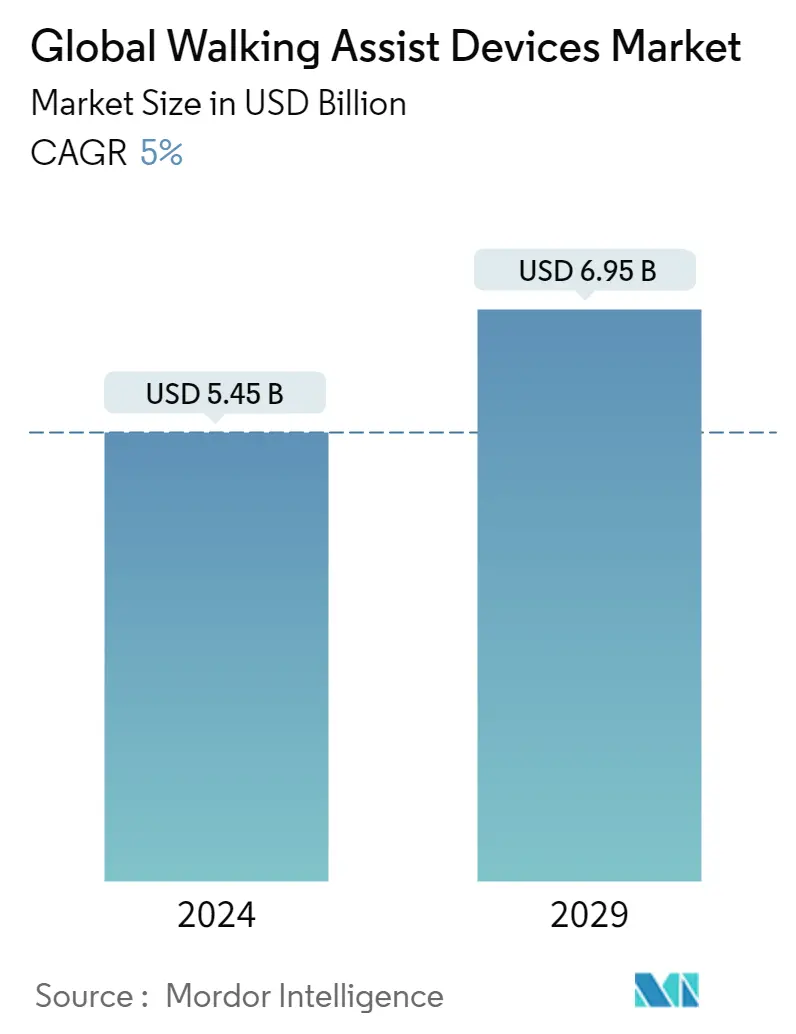Market Size of Global Walking Assist Devices Industry

| Study Period | 2019 - 2029 |
| Market Size (2024) | USD 5.45 Billion |
| Market Size (2029) | USD 6.95 Billion |
| CAGR (2024 - 2029) | 5.00 % |
| Fastest Growing Market | Asia Pacific |
| Largest Market | North America |
Major Players
*Disclaimer: Major Players sorted in no particular order |
Walking Assist Devices Market Analysis
The Global Walking Assist Devices Market size is estimated at USD 5.45 billion in 2024, and is expected to reach USD 6.95 billion by 2029, growing at a CAGR of 5% during the forecast period (2024-2029).
Covid-19 has significantly impacted the walking assist devices market due to the supply chain pressures faced across the globe. For instance, according to the news published titled 'Equipment amnesty called in response to supply chain pressures' in August 2021, pressures on the supply chain are causing a scarcity of essential items including hoists, hospital beds, mobility, and toileting aids. This might have impacted the market growth due to the dramatic decline in sales of walking assist devices during the pandemic.
The key factors propelling the market are the increasing incidences of rheumatoid and osteoarthritis, the surging demand for rehabilitation equipment, and the steep rise in the aging population.
The rise in the elderly population and rise in the prevalence of musculoskeletal disorders such as osteoarthritis, rheumatoid arthritis, among others has also led to the growth of the walking assist devices market. For instance, in June 2022, according to the World Health Organization (WHO), approximately 1.71 billion people have musculoskeletal conditions worldwide. Such a huge prevalence of musculoskeletal disorders will lead to increased adoption of walking assist devices, driving the market growth.
Furthermore, the increasing prevalence of debilitating neurological diseases, rheumatoid arthritis, and osteoarthritis have been contributing to the increased percentage of the population with a disability to walk. For instance, according to the Global RA Network in 2021, more than 350 million people throughout the world suffer from arthritis, which is a prevalent health issue and a major contributor to disability. This will further lead to higher adoption of walking assist devices driving the market growth.
Moreover, as the geriatric population is growing, the demand for walking assist devices is also rising across the world. Also, the walking assist devices provide balance, support, and ultimately, the subsequent ability to survive independently. The aforementioned factors are responsible for the increasing geriatric population getting attracted to these devices.
In addition, the rise in healthcare expenditure and funding by the government for the development of robots to improve health are also significantly contributing to the market growth across the world. However, high cost of purchase of walking assist devices act as a restriaing factor for the market studied.
Walking Assist Devices Industry Segmentation
As per the scope of the report, walking assist devices are designed for people suffering from leg injuries or who are unable to walk due to any internal problem. These devices are also used by people who face the problem of body balance during walking, due to nervous system diseases, such as Parkinson's disease. The Walking Assist Devices Market is segmented by Product Type (Gait Belt and Lift Vest, Cane, Crutch, Walker, Wheelchair, and Power Scooter) and Geography (North America, Europe, Asia-Pacific, Middle East and Africa, and South America). The market report also covers the estimated market sizes and trends for 17 different countries across major regions, globally. The report offers the value (in USD million) for the above segments.
| By Product Type | |
| Gait Belt and Lift Vest | |
| Cane | |
| Crutch | |
| Walker | |
| Wheelchair | |
| Power Scooter |
| Geography | ||||||||
| ||||||||
| ||||||||
| ||||||||
| ||||||||
|
Global Walking Assist Devices Market Size Summary
The walking assist devices market is poised for steady growth over the forecast period, driven by several key factors. The increasing prevalence of musculoskeletal disorders, such as rheumatoid and osteoarthritis, alongside a rising geriatric population, is significantly boosting the demand for these devices. The market has faced challenges due to supply chain disruptions caused by the COVID-19 pandemic, which temporarily impacted sales. However, the growing need for rehabilitation equipment and the increasing number of individuals with disabilities to walk are propelling market expansion. The crutches segment, in particular, is expected to experience rapid growth due to their widespread use as supportive walking devices and their role in rehabilitative care. Campaigns promoting crutch donations and innovations in crutch technology further support this segment's development.
Regionally, North America is anticipated to hold a substantial market share, supported by a well-developed healthcare infrastructure, technological advancements, and a significant geriatric population. The prevalence of arthritis in the United States is a major driver for the market, with ongoing initiatives by key players to develop innovative products. The market is characterized by fragmentation and competitiveness, with numerous companies employing strategies like partnerships and product launches to enhance their market presence. Notable players include Honda Motor Co. Ltd, GF Health Products Inc., and Invacare Corporation, among others. Recent advancements, such as bionic clothing and smart walking canes, highlight the industry's focus on integrating technology to improve mobility solutions.
Global Walking Assist Devices Market Size - Table of Contents
-
1. MARKET DYNAMICS
-
1.1 Market Overview
-
1.2 Market Drivers
-
1.2.1 Increasing Incidences of Rheumatoid and Osteo-arthritis
-
1.2.2 Surging Demand for Rehabilitation Equipment
-
1.2.3 Steep Rise in the Aging Population
-
-
1.3 Market Restraints
-
1.3.1 High Cost of Purchase
-
-
1.4 Porter's Five Forces Analysis
-
1.4.1 Threat of New Entrants
-
1.4.2 Bargaining Power of Buyers/Consumers
-
1.4.3 Bargaining Power of Suppliers
-
1.4.4 Threat of Substitute Products
-
1.4.5 Intensity of Competitive Rivalry
-
-
-
2. MARKET SEGMENTATION (Market Size by Value - USD million)
-
2.1 By Product Type
-
2.1.1 Gait Belt and Lift Vest
-
2.1.2 Cane
-
2.1.3 Crutch
-
2.1.4 Walker
-
2.1.5 Wheelchair
-
2.1.6 Power Scooter
-
-
2.2 Geography
-
2.2.1 North America
-
2.2.1.1 United States
-
2.2.1.2 Canada
-
2.2.1.3 Mexico
-
-
2.2.2 Europe
-
2.2.2.1 Germany
-
2.2.2.2 United Kingdom
-
2.2.2.3 France
-
2.2.2.4 Italy
-
2.2.2.5 Spain
-
2.2.2.6 Rest of Europe
-
-
2.2.3 Asia-Pacific
-
2.2.3.1 China
-
2.2.3.2 Japan
-
2.2.3.3 India
-
2.2.3.4 Australia
-
2.2.3.5 South Korea
-
2.2.3.6 Rest of Asia-Pacific
-
-
2.2.4 Middle-East and Africa
-
2.2.4.1 GCC
-
2.2.4.2 South Africa
-
2.2.4.3 Rest of Middle-East and Africa
-
-
2.2.5 South America
-
2.2.5.1 Brazil
-
2.2.5.2 Argentina
-
2.2.5.3 Rest of South America
-
-
-
Global Walking Assist Devices Market Size FAQs
How big is the Global Walking Assist Devices Market?
The Global Walking Assist Devices Market size is expected to reach USD 5.45 billion in 2024 and grow at a CAGR of 5% to reach USD 6.95 billion by 2029.
What is the current Global Walking Assist Devices Market size?
In 2024, the Global Walking Assist Devices Market size is expected to reach USD 5.45 billion.

